Aggressive seaweed smothers one of world’s most remote reefs
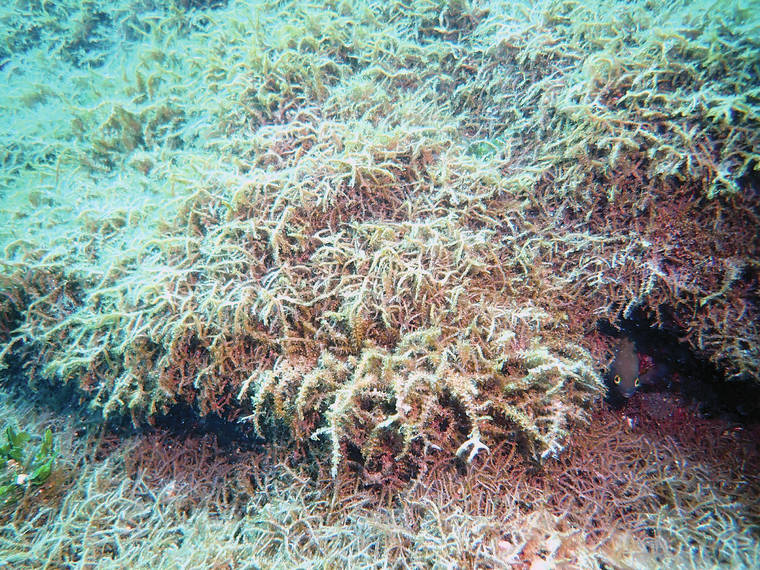
A new species of seaweed, seen here covering coral on a reef at Pearl and Hermes Atoll in the remote Northwestern Hawaiian Islands, is killing large patches of coral on once-pristine reefs and is rapidly spreading across one of the most remote and protected ocean environments on Earth. (Heather Spalding/College of Charleston via AP)
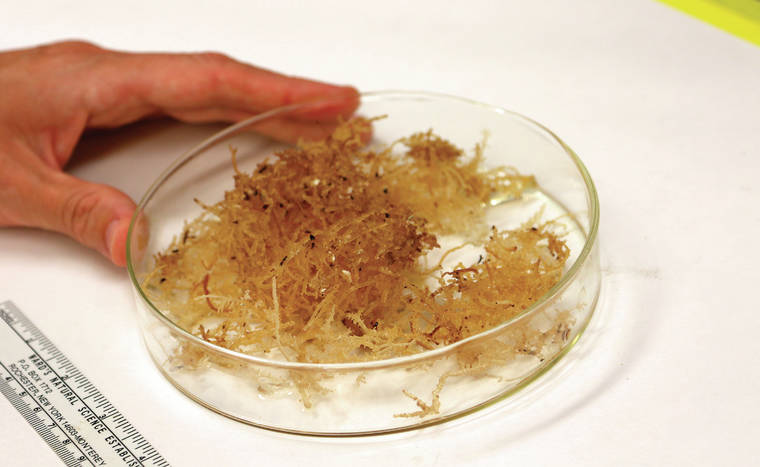
University of Hawaii at Manoa Interim Associate Dean and Professor Alison Sherwood looks at a new species of seaweed found in the Northwestern Hawaiian Islands in late June in her lab in Honolulu. Sherwood, chief scientist on a study that identified the new species, said the aggressive seaweed is overtaking one of the most remote and protected coral reefs in the world. The algae forms huge, thick mats of vegetation that is killing the coral beneath it. (AP Photo/Caleb Jones)
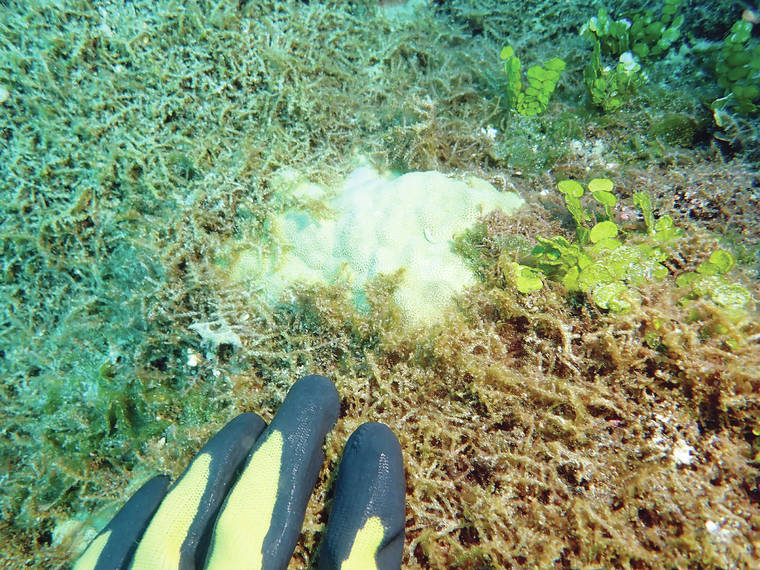
A study from the University of Hawaii and others says the seaweed is spreading more rapidly than anything they've seen in the Northwestern Hawaiian Islands, a nature reserve that stretches more than 1,300 miles north of the main Hawaiian Islands. The algae easily breaks off and rolls across the ocean floor like tumbleweed, scientists say, covering nearby reefs in thick vegetation that out-competes coral for space, sunlight and nutrients. (Heather Spalding/College of Charleston via AP)
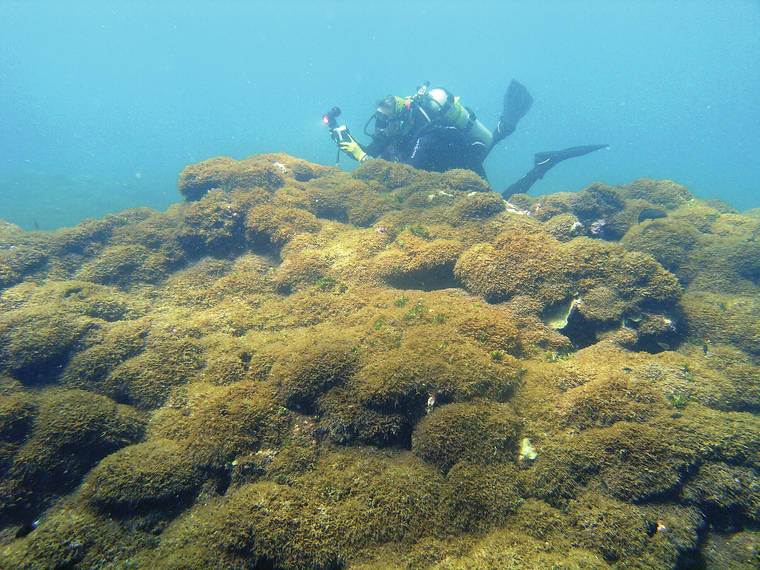
A new species of seaweed covers dead a coral reef at Pearl and Hermes Atoll in the remote Northwestern Hawaiian Islands in this August 2019 photo. Researchers say the recently discovered species of seaweed is killing large patches of coral on once-pristine reefs and is rapidly spreading across one of the most remote and protected ocean environments on Earth. Below, a diver holds a mat of the seaweed. (Photos by Taylor Williams/College of Charleston via AP)
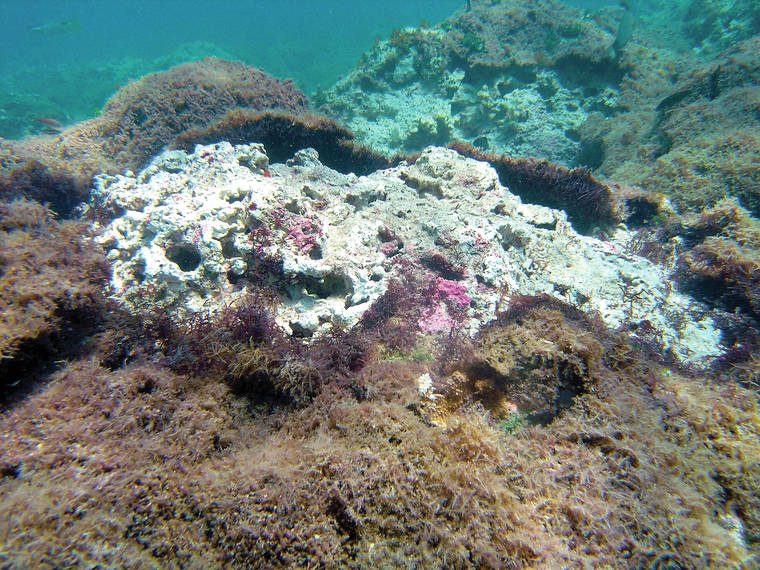
In this July 31, 2019 photo provided by researcher Heather Spalding, a new species of seaweed covers dead coral on a reef at Pearl and Hermes Atoll in the remote Northwestern Hawaiian Islands. Researchers say the recently discovered species of seaweed is killing large patches of coral on once-pristine reefs and is rapidly spreading across one of the most remote and protected ocean environments on earth. A study from the University of Hawaii and others says the seaweed is spreading more rapidly than anything they’ve seen in the Northwestern Hawaiian Islands, a nature reserve that stretches more than 1,300 miles north of the main Hawaiian Islands. The algae easily breaks off and rolls across the ocean floor like tumbleweed, scientists say, covering nearby reefs in thick vegetation that out-competes coral for space, sunlight and nutrients. (Heather Spalding/College of Charleston via AP)
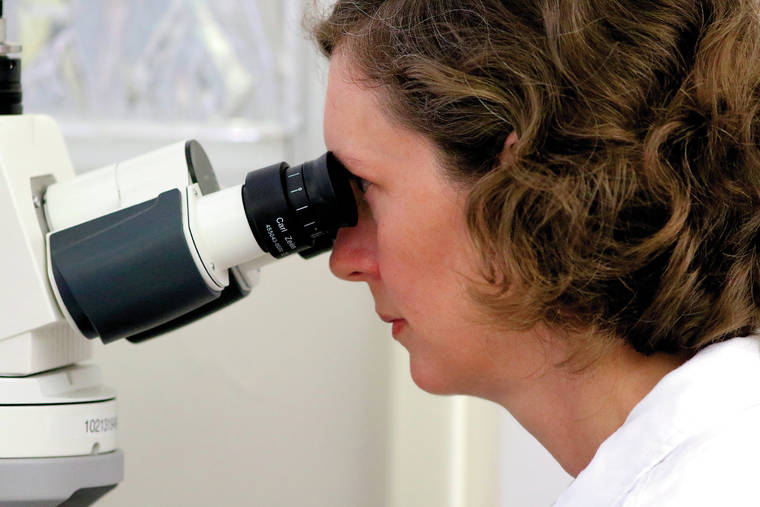
University of Hawaii at Manoa Interim Associate Dean and Professor Alison Sherwood looks at a new species of seaweed found in the Northwestern Hawaiian Islands, Friday, June 19, 2020 in her lab in Honolulu. Sherwood, chief scientist on a study that identified the new species, said the aggressive seaweed is overtaking one of the most remote and protected coral reefs in the world. The algae forms huge, thick mats of vegetation that is killing the coral beneath it. (AP Photo/Caleb Jones)
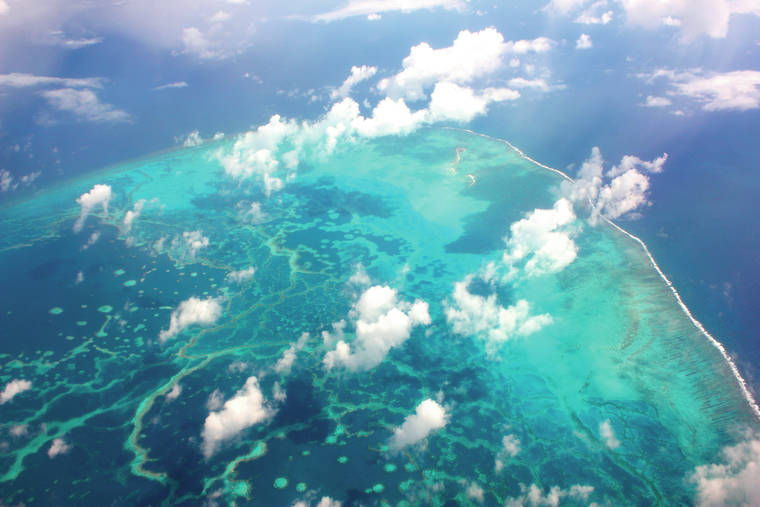
This Aug. 10, 2015, aerial photo provided by the National Oceanic and Atmospheric Administration, shows the Pearl and Hermes Atoll in the Northwestern Hawaiian Islands' Papahanaumokuakea Marine National Monument. Researchers say a recently discovered species of seaweed is killing large patches of coral on once-pristine reefs and is rapidly spreading across the uninhabited atoll. (Andy Collins/NOAA via AP)
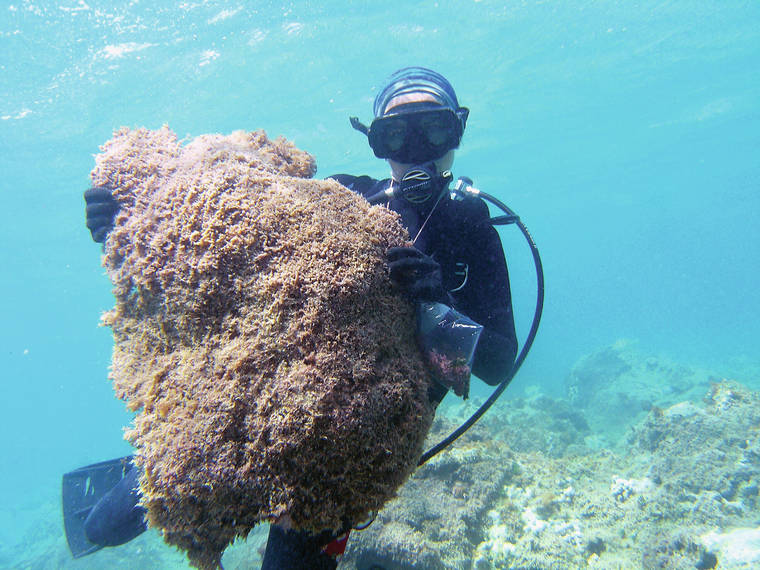
A thick mat of a new species of seaweed is held by a diver at Pearl and Hermes Atoll in the remote Northwestern Hawaiian Islands in June 2019. (Heather Spalding/College of Charleston via AP)
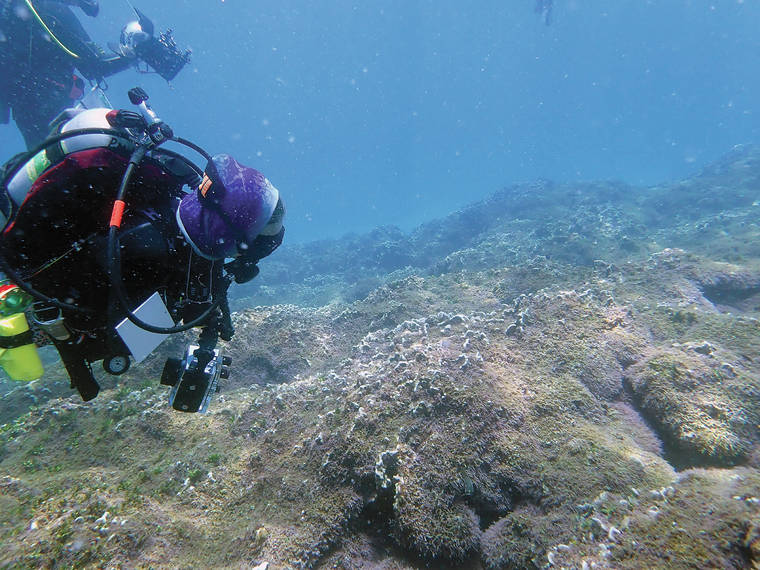
Divers look at a new species of seaweed covering a coral reef at Pearl and Hermes Atoll in the remote Northwestern Hawaiian Islands in August 2019. Researchers say the recently discovered species of seaweed is killing large patches of coral on once-pristine reefs and is rapidly spreading across one of the most remote and protected ocean environments on earth. The algae easily breaks off and rolls across the ocean floor like tumbleweed, scientists say, covering nearby reefs in thick vegetation that out-competes coral for space, sunlight and nutrients. (Heather Spalding/College of Charleston via AP)
HONOLULU — Researchers say a recently discovered species of seaweed is killing large patches of coral on once-pristine reefs and is rapidly spreading across one of the most remote and protected ocean environments on earth.
HONOLULU — Researchers say a recently discovered species of seaweed is killing large patches of coral on once-pristine reefs and is rapidly spreading across one of the most remote and protected ocean environments on earth.
A study from the University of Hawaii and others says the seaweed is spreading more rapidly than anything they’ve seen in the Northwestern Hawaiian Islands, a nature reserve that stretches more than 1,300 miles north of the main Hawaiian Islands.
The study was published in the journal PLOS ONE on Tuesday.
The algae easily breaks off and rolls across the ocean floor like tumbleweed, scientists say, covering nearby reefs in thick vegetation that out-competes coral for space, sunlight and nutrients.
“This is a highly destructive seaweed with the potential to overgrow entire reefs,” said biologist Heather Spalding, a study co-author and longtime Hawaii algae researcher. “We need to figure out where it’s currently found, and what we can do to manage it.”
In 2016, government researchers were on a routine survey of Pearl and Hermes Atoll when they found small clumps of seaweed they’d never seen before.
Last summer, they returned to find algae had taken over huge areas of the reef — in some areas covering “everything, as far as the eye could see” — with seaweed nearly 8 inches thick, said Spalding, who was among the divers there.
“Everything underneath of it was dead,” she said.
The area was mostly devoid of large schools of tropical fish and other marine life that usually cruise the vibrant reef, and fish that typically eat algae were not grazing on the new seaweed, researchers said.
Dives along the outer reef of the 15-mile atoll revealed the seaweed in varying densities and depths.
Scientists say the actual coverage area is likely much larger than documented because they couldn’t survey many sites during their brief visit.
Close to Midway Atoll, site of a pivotal World War II air and sea battle, Pearl and Hermes Atoll is mid-Pacific about 2,000 miles from Asia and North America.
The uninhabited atoll is in the 600,000-square-mile Papahanaumokuakea Marine National Monument, one of the world’s largest protected marine environments.
Noting that individual mats of seaweed were as big as several soccer fields, researchers say the algae could dramatically alter Pearl and Herme’s reef and threaten the entire Hawaiian archipelago if it spreads.
Hawaii’s main islands have several established invasive seaweeds, but cases in the remote northwest are rare.
“We have, not until now, seen a major issue like this where we have a nuisance species that’s come in and made such profound changes over a short period of time to the reefs,” said University of Hawaii at Manoa Interim Associate Dean and Professor Alison Sherwood, chief scientist on the study.
Researchers studied the seaweed’s DNA to try to determine its origin but concluded it’s a new species of red algae they named Chondria tumulosa.
The algae can spread in various ways, Sherwood said. It produces tumbleweed-like clumps that move around the immediate area, but it also generates spores that could be traveling much greater distances.
Among the unknowns are why the algae is growing so fast and how it reached such a remote place.
Scientists say seaweed blooms happen worldwide and can be seasonal, but this does not appear to be the case. The National Oceanic and Atmospheric Administration has been monitoring the site for over 20 years.
“When you see something unusual in the last few years, you can be pretty sure that this is something that’s a bit special as opposed to just things that change from year to year,” said University of Queensland Professor Peter Mumby, who is also chief scientist for Australia’s Great Barrier Reef Foundation. “But it is a matter of concern whenever you see an ecosystem start to display symptoms … like this.”
Mumby, who was not involved with the Hawaii research, said more needs to be done to understand what is driving the seaweed growth.
But he noted that in other parts of the world algae blooms often occur because fish that eat the plants have been harvested or forced to relocate by environmental changes.
The new seaweed could have been introduced by a boat or marine debris. But there is no fishing allowed at Pearl and Hermes, and any ship that enters the region is required to have been inspected and cleaned. The species could also be native, having lived in small, unseen nooks and crannies before a change in local conditions caused it to bloom, researchers said.
The NOAA research crews will soon return to study the outbreak and find out if currents have spread it to nearby Midway, home to the Battle of Midway National Memorial, a U.S. Fish and Wildlife Service base and the region’s only airstrip.
The first order of business, officials say, is to ensure anyone studying the seaweed doesn’t inadvertently spread it.
“All of our dive gear, all of our boats, everything got saturated with bleach,” said Randall Kosaki, NOAA research coordinator at the marine monument and expedition lead for the earlier surveys.
“If something like this got back to Waikiki or anywhere in the main Hawaiian Islands it would be an ecological disaster, but also an economic disaster,” Kosaki said. “You can imagine what that would do to tourism to have an algae like this overgrowing the reefs.”


